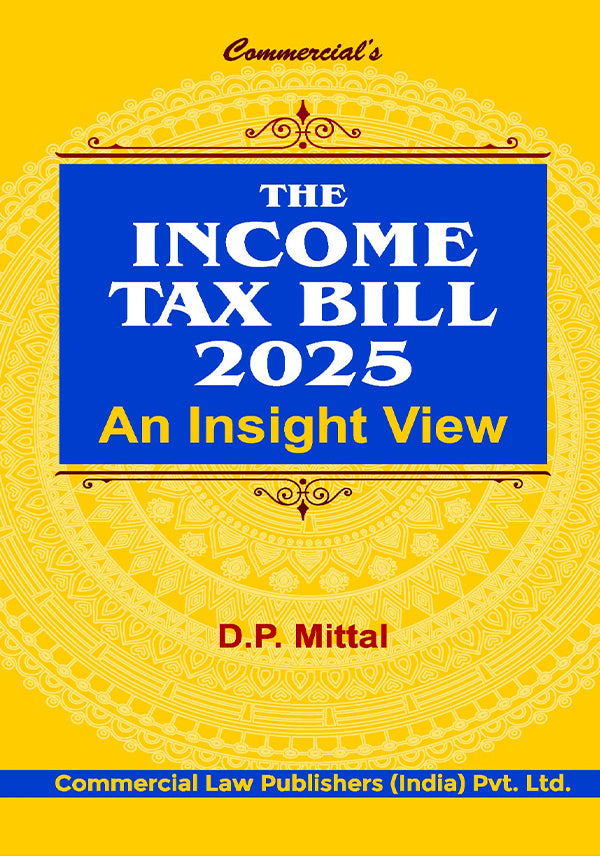Chapter 1—Income Tax Bill, 2025 – A Hurried Legislation
1.1 Introduction 1
1.2 Economic legislation and every major amendments in Income-tax Act preceded by Committee’s reports 2
1.3 Income-tax Bill, 2025 – Framed by Bureaucracy and not on the basis of an Expert Opinion 5
1.4 Ill digested Code in a frenzy of hurry 6
1.5 Income-tax Bill, 2025 based on Bureaucratic Opinion 7
Chapter 2—Income-tax Act Complex – A Myth
2.1 Introduction 17
2.2 Legislature allowed greater “play in the joints” 17
2.3 Complexity common features of all taxation laws 18
2.4 Administration of tax laws—Litigation not because of complexity 20
2.5 Tax administration 21
2.6 Administration of the Act-Public perception 23
2.7 High pitched assessments, erosion of tax base, proliferation of black money-reflective of the disease 24
2.8 Ostrich type approach 25
Chapter 3—Legal or Lay Language
3.1 Introduction 26
3.2 Tax laws believed complex being not drafted in a common man language 27
3.3 Plain and unambiguous language is delusion 27
3.4 Simple language may not appear simple to the court 28
3.5 Legislative drafting devices and technique sacrificed for sake of simplicity-confusion 29
3.6 Proviso – Function 30
3.7 Explanation Function 30
3.8 Draft Bill, 2025 enacted “explanations” as sub-sections 32
3.9 Placing qualifying and explaining expressions immediately after the clauses and not distantly away 33
3.10 “Irrespective of” in place of “notwithstanding” 34
3.11 Legislation in algebraic equations and symbols and not in words 35
3.12 Mathematical equations do not enact anything 36
3.13 Aggregation is not the total of all income but refers to income for which there is no source 37
3.14 Referential incorporation 42
Chapter 4—Income not to be Included in Total Income
4.1 Introduction 43
4.2 Schedule not a proper place 44
4.3 Central Government making rules 44
4.4 Income of political and electoral trusts 45
Chapter 5—Tax Year
5.1 Introduction 46
5.2 Substitution of tax year for the previous and the assessment year 46
5.3 Concepts of previous year and assessment year under the Income-tax Act, 1961 47
5.4 Liability to pay tax 47
5.5 Previous year (financial year) and assessment year are two necessary concepts 48
5.6 Income becoming taxable during financial year escape chargeability 48
5.7 Previous year and assessment year cannot be expressed by one expression, i.e., financial year 49
Chapter 6—Expenditure for Prohibited Purposes
6.1 Expenditure for purpose which is offence or prohibited-not allowed 50
6.2 Expenses related to income from lotteries, crossword, etc. [section 94(4)] 52
Chapter 7—Non-profit Organisations
7.1 Introduction 53
7.2 Property held in trust 54
7.3 Non-profit organisation – concept of total income and computation incompatible 56
7.4 Non-profit organisation is a person 56
7.5 Public trust is not a person or organisation but an obligation 56
7.6 Commercial activities 58
7.7 Determination of income business undertaking – No provision in the Act 60
7.8 Accreted income 61
7.9 Charitable purpose – definition 62
Chapter 8—Income-tax Act, 1961 be Retained
8.1 Introduction 64
8.2 The Indian Income-tax Act, 1961 – certain, clear and consistent 64
8.3 Two concepts even the Income-tax Bill, 2025 does not have answer 65
8.4 Best way to amend the tax laws is to retain the basic fabric of
the Income-tax Act, 1961




